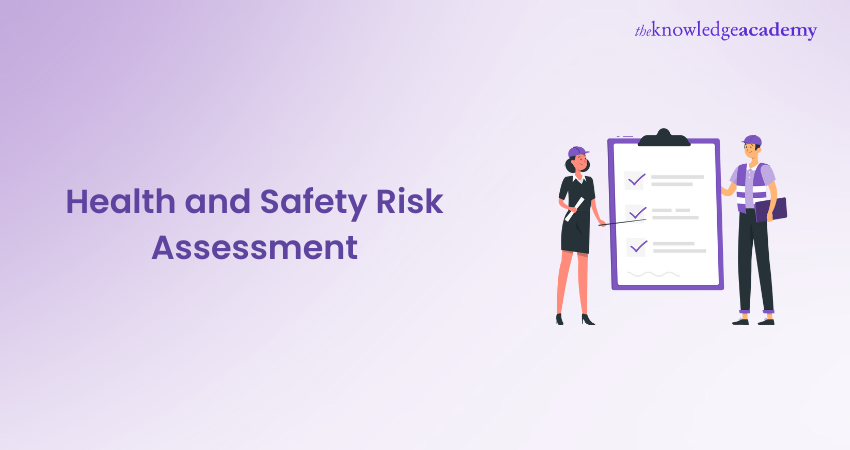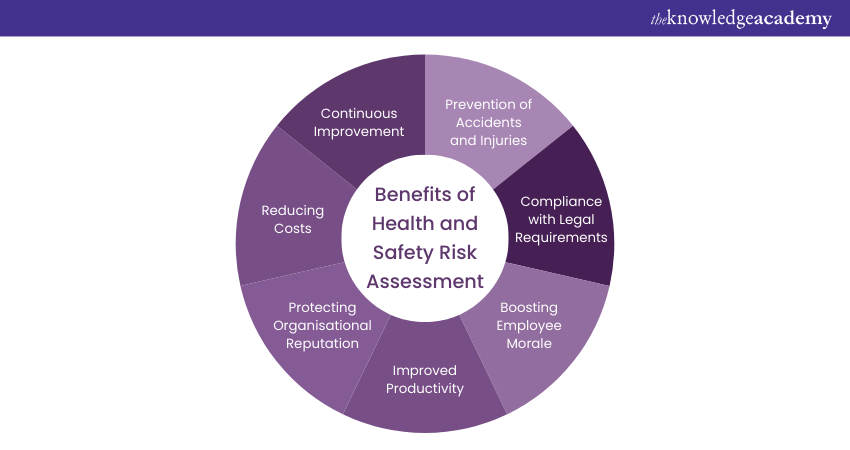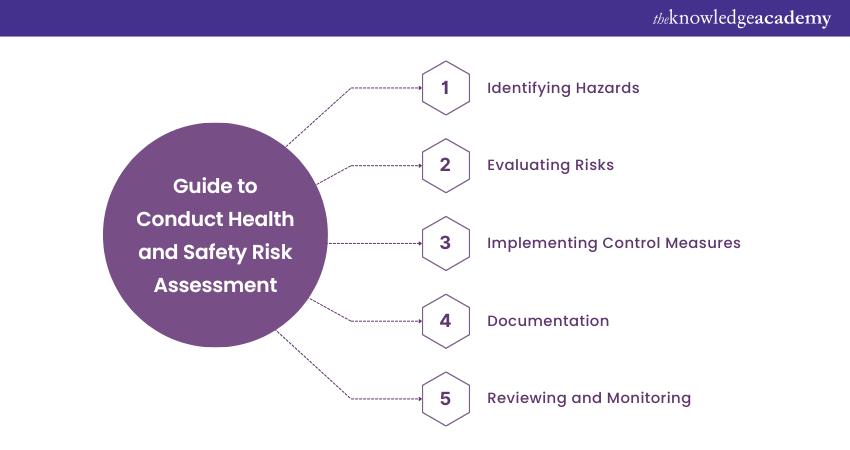We may not have the course you’re looking for. If you enquire or give us a call on +44 1344 203 999 and speak to our training experts, we may still be able to help with your training requirements.
We ensure quality, budget-alignment, and timely delivery by our expert instructors.

In today's fast-paced and dynamic work environments, ensuring the well-being of employees is of paramount importance. Organisations across various industries face a multitude of potential hazards and risks that can lead to accidents, injuries, and even fatalities. This is where the need for regular risk assessments for ensuring safety and health becomes crucial.
A Health and Safety Risk Assessment is a systematic process that involves identifying, assessing, and managing potential hazards and risks within a workplace setting. By proactively evaluating these risks, organisations can take appropriate measures to prevent incidents and create a secure environment for their employees, visitors, and stakeholders.
This blog delves into what a Health and Safety Risk Assessment is, how it is conducted, its significance, and challenges.
Table of Contents
1) What is Risk Assessment?
2) What is a Health and Safety Risk Assessment?
3) Significance of Risk Assessment for Safety and Health
4) Health and Safety Risk Assessment Steps
5) Health and Safety Risk Assessments: Challenges
6) Conclusion
What is Risk Assessment?
Risk assessment is an organised way to systematically identify, analyse and mitigate the risks and hazards in any environment. The main objective of this activity is to ensure the safety of the employees, staff and each individual in the workplace. Risk Assessment approaches vary based on the type of organisations like healthcare, construction, and retail businesses.
What is a Health and Safety Risk Assessment?
At its core, a risk assessment to ensure safety and health is a systematic approach to identifying, assessing, and managing potential hazards and risks within a workplace setting. It involves a careful examination of the work environment, processes, activities, and materials present to determine the severity of any potential harm they may pose to individuals.
The objective of a risk assessment includes proactively identifying potential hazards and taking appropriate measures to control and minimise the associated risks. By doing so, organisations can create a safer and healthier work environment for everyone involved.
A thorough risk assessment considers various factors, such as:
a) The nature of the work
b) The equipment and tools used
c) The layout of the workplace
d) The potential exposure to hazardous substances or activities
e) The needs and vulnerabilities of employees, visitors, and other stakeholders who may be present in the workplace
Moreover, a risk assessment serves as a foundation for developing robust safety policies and procedures. It guides the implementation of preventive measures, such as training programs, safety protocols, and the provision of personal protective equipment (PPE).
Ultimately, the primary purpose of the assessment is to prevent workplace accidents, injuries, and illnesses. It is a continuous process that must include continuous monitoring, evaluation, and improvement to ensure the effectiveness of control measures and the overall safety of the workforce.
To learn about risk assessment and clear the exam, refer to our blog on "Nebosh Question Paper"
Significance of Risk Assessment for Safety and Health
Safety and health risk assessment plays a pivotal role in fostering a safe and secure work environment. It is not merely a bureaucratic exercise but a critical process that has tangible benefits for organisations and individuals alike. Let's explore some of its benefits in detail:

a) Prevention of Accidents and Injuries: The foremost importance of assessing risks is its ability to identify and mitigate potential hazards. Organisations can proactively address risks by conducting thorough examinations before they lead to accidents, injuries, or even fatalities. This preventive approach is crucial for ensuring the well-being of employees and reducing the financial and human costs associated with workplace incidents.
b) Compliance with Legal Requirements: Safety and health regulations are legal obligations for organisations. Conducting regular risk assessments helps ensure that workplaces meet the necessary legal standards and requirements.
The inability to comply with these regulations can result in penalties, legal consequences, and damage to the organisation's reputation. Effective assessment of risks enables organisations to identify gaps and take appropriate measures to comply with the law.
c) Boosting Employee Morale: Employees have the right to work in a safe and healthy environment. When organisations prioritise safety and health through assessing risks, it demonstrates a commitment to the well-being of their workforce.
This, in turn, boosts employee morale, confidence, and job satisfaction. When employees feel safe, they are more engaged, productive, and motivated, contributing positively to the organisation's overall success.
d) Improved Productivity: Creating a safe workplace is essential for boosting productivity. By identifying and addressing potential hazards and risks, organisations can provide a secure environment where employees can concentrate on their tasks without any unnecessary worries or distractions about their safety.
This leads to improved productivity, efficiency, and quality of work. Additionally, implementing control measures identified through risk assessments can streamline processes, reduce downtime, and optimise resource allocation.
e) Protecting Organisational Reputation: Organisations with a strong commitment to Health and Safety build a positive reputation in their industry and among stakeholders. Conversely, incidents resulting from neglecting risk assessments can lead to negative publicity, damage the organisation's brand image, and erode trust.
By prioritising risk assessment, organisations demonstrate their dedication to the well-being of their employees and the communities they operate in, safeguarding their reputation.
f) Reducing Costs: Workplace accidents and injuries can have significant financial implications for organisations. Medical expenses, compensation claims, legal fees, and insurance premiums can put a strain on resources. Organisations can minimise the financial burden associated with accidents and injuries by identifying and mitigating risks through effective Nebosh risk assessment, thereby protecting their bottom line.
g) Continuous Improvement: Risk assessment is an ongoing process that encourages continuous improvement in safety practices. Organisations can stay abreast of emerging risks, new technologies, and industry best practices through regular reviews and updates. This promotes a culture of innovation, adaptability, and continuous learning, positioning the organisation at the forefront of safety advancements.
Want to expand your understanding of relevant Health and Safety legislation and standards? Our NEBOSH National General Certificate in Occupational Health and Safety Course will help you out - Register now!
Health and Safety Risk Assessment Steps
Conducting a thorough risk assessment to ensure safety and health involves a series of key steps. By following these steps, organisations can systematically identify, evaluate, and manage potential hazards and risks within their workplace. Let's explore each step in detail:

1) Identifying Hazards
The first step involves identifying all potential hazards present in the workplace. This includes physical hazards (machinery, chemicals, noise), ergonomic hazards (repetitive tasks, improper lifting), biological hazards (infectious materials), and psychosocial hazards (workplace stress, bullying). It is suggested to involve employees in identifying risks, consulting safety guidelines, and reviewing incident records.
2) Evaluating Risks
The second step refers to the evaluation of the risks associated with each identified hazard. But before that, it is essential to identify the individuals who may be exposed to the hazards, including employees, contractors, visitors, and the public.
Once that is done, you must assess the likelihood and severity of potential harm, taking into account existing control measures. This step helps prioritise risks based on their significance and aids in developing appropriate control strategies. You can utilise quantitative or qualitative methods to assess risks like risk matrices, hazard checklists, or expert judgements.
3) Implementing Control Measures
The third step involves the implementation of suitable control measures to eliminate or minimise risks. Consider the hierarchy of controls, which includes eliminating the hazard, substituting it with a safer alternative, implementing engineering controls, introducing administrative controls (training, procedures), and providing Personal Protective Equipment (PPE). Ensure control measures are practical, effective, and specific to the identified risks.
4) Documentation
After identifying and assessing risks, the next step is to document the findings. This includes the identified hazards, assessed risks, and control measures. You must maintain clear and concise records to demonstrate compliance with legal requirements and provide a reference for future reviews. Communicate the risk assessment results to all relevant stakeholders, ensuring they understand the risks and control measures in place.
5) Reviewing and Monitoring
The final step involves regularly reviewing and monitoring the effectiveness of control measures and the overall risk assessment process. It is essential to monitor all the changes in the workplace, new technologies, and industry developments that may introduce new hazards or require updated control measures. Seek feedback from employees, conduct inspections, and analyse incident reports to identify areas for improvement.
By following these key steps, organisations can effectively manage risks and create a safer work environment for their employees. It is essential to note that risk assessment is a continuous process, and continued improvement is vital to adapt to evolving hazards and maintain a strong safety culture.
Enhance awareness and reduce the risks of workplace accidents through our Health and Safety in the Workplace Training - Sign up now!
Health and Safety Risk Assessment: Challenges
While risk assessments are crucial for maintaining a safe work environment, organisations may encounter various challenges and pitfalls during the process. Being aware of these challenges can help enterprises navigate them effectively. Let's explore some of these challenges:
1) Insufficient Resources and Support: Limited resources, both in terms of personnel and finances, can hinder the effectiveness of assessing risks. Lack of dedicated time, expertise, and support from management may result in rushed assessments or inadequate control measures. Organisations should allocate sufficient resources and provide the necessary training and support to tackle this challenge.
2) Inadequate Employee Involvement: Employees must be included in the process of assessing risks to avoid overlooking critical hazards and control measures. Employees have valuable knowledge and insights regarding their work tasks and the associated risks. Therefore, involving them in the risk assessment process not only improves the accuracy of the assessment but also fosters a sense of ownership and commitment to safety.
3) Lack of Risk Awareness: Some organisations may have limited awareness or understanding of potential hazards and risks in their work environment. This can result in an incomplete or inaccurate assessment of risks. Therefore, it is essential to continuously educate and train employees, supervisors, and managers on risk assessment techniques, hazard recognition, and control measures.
4) Failure to Address Changing Work Conditions: Workplaces are dynamic environments that change over time. New equipment, processes, or organisational changes can introduce or alter new hazards. Failing to review and update the assessment of risks periodically may result in outdated control measures and ineffective risk management.
5) Inconsistent Application of Control Measures: Inconsistencies in applying control measures can undermine the effectiveness of risk assessments. Lack of clarity, enforcement, or accountability regarding the implementation of control measures can lead to gaps in safety practices. Organisations should ensure that control measures are consistently applied and monitored across all work areas.
6) Overreliance on Generic Risk Assessments: Relying solely on generic risk assessments without considering the specific context of the workplace can be insufficient. Each workplace has unique characteristics, processes, and hazards that require a tailored evaluation of risks. Generic templates should be customised and supplemented with site-specific information to identify and address workplace risks accurately.
7) Failure to Regularly Review and Update Assessments: Assessment of risks should be living documents that evolve with changing circumstances. Failure to regularly review and update assessments can lead to obsolete or inaccurate information. Organisations should establish a review schedule and promptly update assessments of risks whenever significant changes occur in the workplace.
8) Lack of Proper Documentation and Communication: Inadequate documentation and communication of the assessment findings can hinder effective risk management. Clear and comprehensive documentation helps track the assessment process, control measures, and any identified areas for improvement. Regular communication with employees and stakeholders ensures awareness and understanding of risks and control measures.
9) Inadequate Training: Insufficient training on the methodologies and techniques of assessing risks can compromise the accuracy and effectiveness of the process. Employees involved in the assessment of risks should receive appropriate training to ensure they possess the necessary knowledge and skills to identify hazards, assess risks, and implement control measures effectively.
10) Failure to Learn From Incidents and Near Misses: Neglecting to analyse incidents, accidents, and misses can result in recurring hazards and risks. Organisations should investigate incidents, identify root causes, and implement corrective actions to prevent future occurrences. Lessons learned from incidents should be incorporated into assessing risks to improve hazard identification and control.
Conclusion
In conclusion, conducting a comprehensive risk assessment for ensuring safety and health is vital for organisations to guarantee the well-being and safety of their employees and create a safe work environment. By understanding the hazards present in the workplace and assessing the associated risks, organisations can implement appropriate control measures to prevent accidents, injuries, and occupational illnesses.
Build and lead an incident investigation team with confidence with our comprehensive Safety Investigation Training - Sign up now!
Frequently Asked Questions
What are the Common Types of Hazards Identified in Risk Assessments?

Common types of hazards identified in risk assessments include:
a) Biological hazards such as viruses, insects, plants, birds, etc.
b) Chemical hazards: Based on the chemical's toxic properties.
c) Ergonomic hazards: Improper workstation setup.
d) Other hazards, such as adverse weather or faulty electrical outlets
What are the Consequences of Failing to Conduct Adequate Risk Assessments?

Consequences of failing to conduct adequate risk assessments include:
a) Increased risk of accidents
b) HSE investigations
c) Enforcement action
d) Not being aware of hazards
e) Not controlling the risks
f) Project delays
What are the Other Resources and Offers Provided by The Knowledge Academy?

The Knowledge Academy takes global learning to new heights, offering over 3,000 online courses across 490+ locations in 190+ countries. This expansive reach ensures accessibility and convenience for learners worldwide.
Alongside our diverse Online Course Catalogue, encompassing 19 major categories, we go the extra mile by providing a plethora of free educational Online Resources like News updates, Blogs, videos, webinars, and interview questions. Tailoring learning experiences further, professionals can maximise value with customisable Course Bundles of TKA.
What is The Knowledge Pass, and How Does it Work?

The Knowledge Academy’s Knowledge Pass, a prepaid voucher, adds another layer of flexibility, allowing course bookings over a 12-month period. Join us on a journey where education knows no bounds.
What are the Related Courses and Blogs Provided by The Knowledge Academy?

The Knowledge Academy offers various Health & Safety Courses including the Health and Safety in the Workplace Training and the Safety Investigation Course. These courses cater to different skill levels, providing comprehensive insights into What is a Health and Safety Audit.
Our Health & Safety Blogs cover a range of topics related to Health and Safety risk assessment, offering valuable resources, best practices, and industry insights. Whether you are a beginner or looking to advance your risk assessment skills, The Knowledge Academy's diverse courses and informative blogs have got you covered.
Upcoming Health & Safety Resources Batches & Dates
Date
 IOSH Managing Safely Course
IOSH Managing Safely Course
Mon 28th Apr 2025
Mon 16th Jun 2025
Mon 28th Jul 2025
Mon 1st Sep 2025
Mon 3rd Nov 2025






 Top Rated Course
Top Rated Course



 If you wish to make any changes to your course, please
If you wish to make any changes to your course, please


